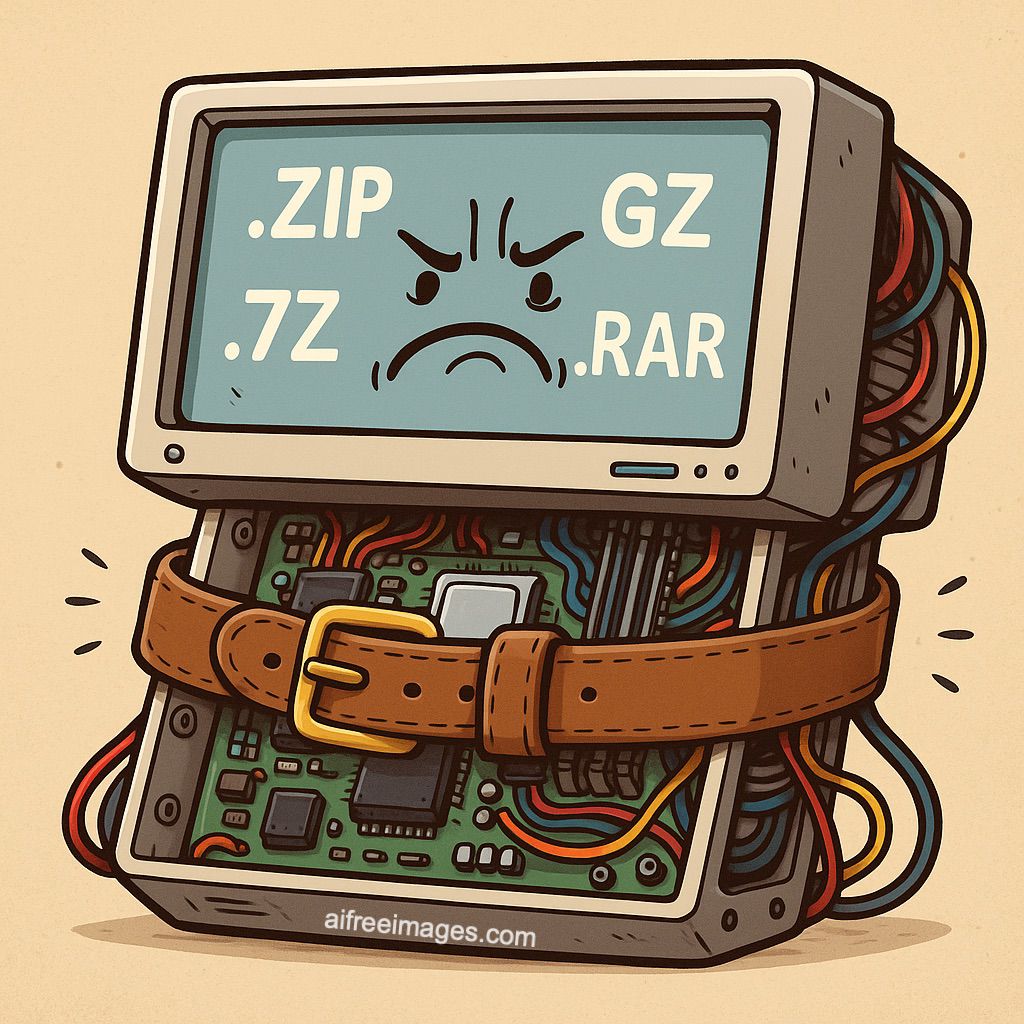From ZIP to Zstandard, including extinct formats like ARJ, LZH or Quantum, this is how data compression has evolved across different platforms and operating systems.
File compression has accompanied the development of computing since its beginnings. Its objective has always been the same: reduce the size of data to save space, accelerate network transmission, and facilitate storage or backup. From the 1980s to the present, dozens of algorithms and formats have been developed, some now obsolete, others that remain current and even in constant evolution.
Table of Contents
This article covers the history of the main compression formats, including some lesser-known ones, their extension, compatibility, advantages, limitations, and curiosities.
From ARC to Quantum: The Prehistory of Compression
In the 1980s, compression was a critical necessity for 360 KB floppy disks and slow modem connections. Some of the first formats included:
| Format | Extension | Year | Current Status | Notes |
|---|---|---|---|---|
| ARC | .arc | 1985 | Obsolete since ~1990 | Caused legal controversy; replaced by ZIP |
| ARJ | .arj | 1990 | Obsolete since ~2000 | Widely used in BBS and floppy disks, great efficiency for its time |
| LZH/LHA | .lzh | 1988 | In disuse since ~2010 | Popular in Japan and AmigaOS, used in some games |
| Q (Quantum) | .q | 1991 | Discontinued in 1994 | High compression in MS-DOS, replaced by ZIP |
| Zoo | .zoo | 1986 | Obsolete since ~1995 | Compression format for Unix |
Extended Table of Modern and Ancient Formats
| Format | Extension | Compression | Advantages | Disadvantages | Compatibility | Status |
|---|---|---|---|---|---|---|
| ZIP | .zip | Medium | Very compatible, fast | Lower compression than others | Windows, macOS, Linux, mobile | Active |
| RAR | .rar | High | Good ratio, error recovery | Proprietary | Windows, macOS, Linux (limited), mobile apps | Active (WinRAR 6.x) |
| 7z | .7z | Very high | Open source, strong encryption, solid compression | Slow in some cases | Windows, macOS, Linux, mobile | Active |
| TAR.GZ | .tar.gz | High (gzip) | Linux standard, good speed | No direct navigation | Linux, Unix, Windows with tools | Active |
| XZ | .xz | Very high | Great compression | Slow, intensive CPU usage | Linux, Windows, macOS | Active |
| Zstandard | .zst | High | Very fast, modern, ideal for backups | Not yet widely adopted | Linux, macOS, Windows (new tools) | Active |
| LZMA | .lzma | Very high | High compression | Less support than .7z | Linux, Windows | Active |
| BZIP2 | .bz2 | High | Better than gzip, lossless | Very slow | Linux, Windows, macOS | Active |
| ARJ | .arj | High | Efficient in its time | Obsolete, limited support | Only old CLI or retro software | Obsolete (~2000) |
| LZH | .lzh | Medium | Used in video games and Japanese software | Low compression, no support | Japan, retrocomputing | Obsolete (~2010) |
| ZOO | .zoo | Medium | Cross-platform in its time | Almost no current support | Retro Unix | Obsolete (~1995) |
| CAB | .cab | Medium | Format used by Microsoft for installers | Windows only, no encryption | Windows | Active (limited use) |
| ACE | .ace | High | Good ratio, was popular in the 2000s | Abandoned, vulnerabilities | Only old versions of WinRAR | Abandoned (since ~2007) |
Platforms and Tools by Operating System
Windows
- Native support: ZIP, CAB
- Key tools: 7-Zip, WinRAR, Bandizip, PeaZip
macOS
- Native support: ZIP, TAR, GZ, XZ
- Tools: Keka, The Unarchiver, BetterZip
Linux
- Complete terminal support: ZIP, 7z, TAR, GZ, BZ2, XZ, Zstandard
- Utilities: tar, gzip, xz, zstd, p7zip
Android and iOS
- Apps: ZArchiver, RAR for Android, WinZip, iZip
- Limitations: Some encrypted or solid formats require paid apps
Curious Cases and Compression Records
ENWIK8 (Wikipedia in text, 100 MB):
- ZIP: ~30 MB
- 7z: ~20 MB
- Zstandard: ~22 MB
- PAQ8px: 13.3 MB
- CMIX: up to 12.7 MB (but takes several hours)
Compression challenges: There are competitions like the Hutter Prize, which reward the algorithm that manages to best compress a copy of Wikipedia, seeking theoretical limits of lossless compression.
Compression Formats by Use Context
| Context | Ideal Format | Reason |
|---|---|---|
| General files | ZIP, 7z | Compatibility and balanced compression |
| Mass backups | TAR.ZST, 7z | Solid and efficient compression |
| Linux distributions | TAR.GZ, TAR.XZ | Traditional and universally supported |
| Multimedia content | RAR, 7z | Solid compression, volume splitting |
| Mobile apps | ZIP, RAR | App limitations |
| Extreme compression | PAQ, CMIX, ZPAQ | Only for testing or historical archiving |
What Does the Future Hold?
Data growth doesn’t stop. Although technologies like real-time compression of file systems (ZFS, Btrfs, ReFS) or deduplication have changed part of the paradigm, classic formats remain alive. Projects like Zstandard or ZPAQ point to a future with smarter, adaptive, and faster algorithms, leveraging multi-core CPUs and abundant memory.
Additionally, content-specific lossless compression (such as PNG images, AV1 video, FLAC audio) continues to evolve in parallel, optimizing resources for each medium.
Conclusion
Far from being relegated by hardware advances or cheaper storage, compression formats remain a key tool for computing efficiency. Whether saving a backup, sending documents by email, or distributing software, choosing the right format can make a big difference.
From the ancient ARJ to the modern Zstandard, compression is a technical art that has evolved with each generation of computers. And, judging by current advances, it hasn’t said its last word yet.
Sources and Recommended Tools:
- https://7-zip.org
- https://www.rarlab.com
- https://facebook.github.io/zstd
- https://peazip.github.io/
- https://www.keka.io/
- Wikipedia: «Comparison of file archivers»
- Archive.org: Technical documentation of old formats
Via: Social Media News

